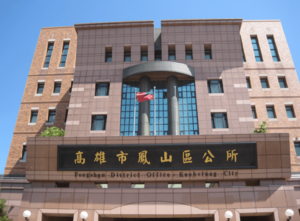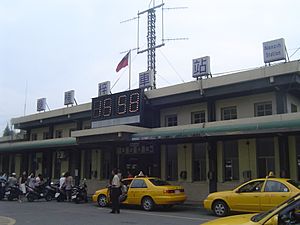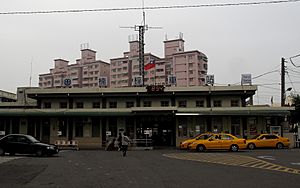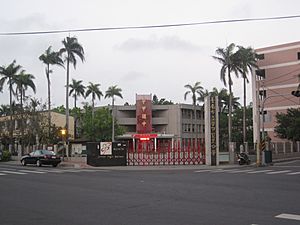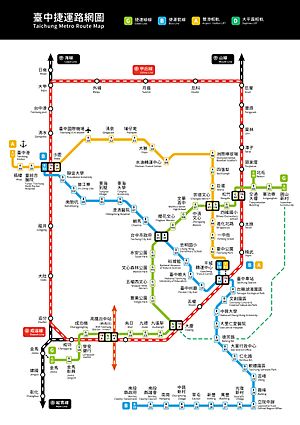Tongyong Pinyin facts for kids
Tongyong Pinyin (which means "general-use spelling of sounds") was a way to write Mandarin Chinese words using the Latin alphabet (like English letters). It was the official system in Taiwan from 2002 to 2008. Before that, it was used unofficially for a couple of years while Taiwan decided on a new system. Taiwan's Ministry of Education approved it in 2002, but using it was not always required.
However, starting on January 1, 2009, the Ministry of Education officially switched to promoting Hanyu Pinyin. This meant that local governments in Taiwan would not get money from the central government if they kept using Tongyong Pinyin. After this change, Tongyong Pinyin is still sometimes used for spelling some place names and people's names in Taiwan. For example, some names of districts, subway stations, and streets in cities like Kaohsiung, Tainan, and Taichung use Tongyong Pinyin. An example is Cijin District.
Contents
Why Tongyong Pinyin Was Created
For many years, Taiwan used different ways to write Chinese words with Latin letters, often based on an older system called Wade–Giles. But there wasn't one clear standard. Taiwan also uses Zhuyin, which is a phonetic system for teaching Chinese sounds in schools, but it doesn't use the Latin alphabet.
Tongyong Pinyin was first suggested in 1998 by a scholar named Yu Bor-chuan. He wanted a system that kept the good parts of Hanyu Pinyin but made it easier for people who don't speak Chinese to pronounce certain letters, like 'q' and 'x'. His system was later changed a bit.
Political Debates About Tongyong Pinyin
Deciding whether to use Tongyong Pinyin became a big debate in Taiwan, often linked to ideas about national identity. Some people felt more connected to Chinese culture, while others felt more strongly about Taiwan's own identity.
- The Democratic Progressive Party (DPP) and its allies, who focused more on Taiwan's unique identity, thought that if Tongyong Pinyin worked better for Taiwan, there was no reason to use Hanyu Pinyin just because Mainland China and the United Nations used it.
- The Kuomintang (KMT), who felt more connected to Chinese culture, thought it was better to use Hanyu Pinyin because it was already accepted around the world.
Each side accused the other of making decisions based on their feelings about China, rather than what was best for Taiwan.
In October 2000, Taiwan's Ministry of Education suggested making Tongyong Pinyin the national standard, but this idea was rejected. Finally, on July 10, 2002, the Ministry of Education held a meeting, and with 10 votes, the plan to use Tongyong Pinyin was passed.
In August 2002, the government officially adopted Tongyong Pinyin. However, local governments could choose to use a different system if they wanted. In October 2007, the DPP government announced that Taiwan would standardize place names using Tongyong Pinyin to reduce confusion from many different spellings.
Switching to Hanyu Pinyin
In 2008, the Kuomintang party won the elections in Taiwan. In September 2008, they announced that Tongyong Pinyin would be replaced by Hanyu Pinyin as Taiwan's standard system. This change officially happened on January 1, 2009.
Even though Hanyu Pinyin is now the official system, people in Taiwan can still choose how they want to spell their own names in English. So, some people still use spellings based on Tongyong Pinyin, Wade–Giles, or other systems for their names.
Where Tongyong Pinyin Was Used
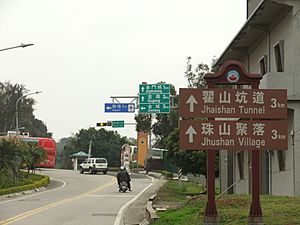
Tongyong Pinyin was the official system, but using it was voluntary. This meant that the way words were spelled could be different depending on which government office was in charge of a place.
- Street signs in many areas, including the cities of Kaohsiung and Tainan, used Tongyong Pinyin.
- For example, Taichung County used Tongyong Pinyin, but Taichung City used Hanyu Pinyin.
- In Taipei, the mayor at the time, Ma Ying-jeou, wanted to use Hanyu Pinyin.
- Taipei County (now New Taipei City) used Tongyong Pinyin. However, in Taipei Metro stations, Tongyong Pinyin was often shown in parentheses after Hanyu Pinyin.
- Many older spellings from Wade–Giles are still popular for personal names and businesses.
The different systems made it hard for the Ministry of Education to replace Zhuyin for teaching pronunciation in elementary schools. Zhuyin is still widely used to teach Mandarin sounds to children in Taiwan. Children's books often show Zhuyin characters next to Chinese characters.
Today, many districts in Kaohsiung still use Tongyong Pinyin in their names. Most districts in Tainan also use Tongyong Pinyin, with a few exceptions like Xinying.
How Tongyong Pinyin Spells Words
Tongyong Pinyin has some special ways of spelling sounds compared to Hanyu Pinyin:
- The first tone (a flat tone) is not marked.
- The sound written as zh- in Hanyu Pinyin becomes jh- in Tongyong Pinyin.
- The sounds x- and q- from Hanyu Pinyin are not used. They become s- and c- in Tongyong Pinyin.
- Certain "empty" vowel sounds that end words like zi or shi in Hanyu Pinyin are written as -ih in Tongyong Pinyin (for example, sih or shih).
- The ü sound (which is sometimes just u after certain letters in Hanyu Pinyin) is replaced by yu in Tongyong Pinyin.
- The -eng sound becomes ong after f- and w- (like in fong or wong).
- The word wen becomes wun.
- The -iong sound becomes yong (like syong instead of Hanyu Pinyin xiong).
- Sometimes, sounds like -iu and -ui can be written out fully as -iou and -uei (like diou or duei). This is especially true for place names at the township level or smaller.
Arguments For and Against Tongyong Pinyin
There were many discussions about whether Tongyong Pinyin was a good system.
Arguments Supporting Tongyong Pinyin
- Easier Pronunciation: Supporters said Tongyong Pinyin helps people who don't speak Chinese pronounce words more accurately. For example, it avoids letters like 'q' and 'x' that can be confusing for English speakers.
- Similar to Hanyu Pinyin: It's not completely different from Hanyu Pinyin, so people familiar with one might still understand the other.
- No Special Marks: It doesn't need special marks for the ü sound.
- Better Sound Representation: Some argued that spellings like "fong" and "wong" better match how those sounds are said in Mandarin in Taiwan.
- Good for Business and Visitors: It was seen as helpful for businesses and tourists because place names would be easier to say and find.
- Taiwan's Own System: It allowed Taiwan to have its own system, balancing international needs with local identity.
- Better than Wade–Giles: Everyone agreed Tongyong Pinyin was better than the old Wade–Giles system, which was still widely used.
Arguments Against Tongyong Pinyin
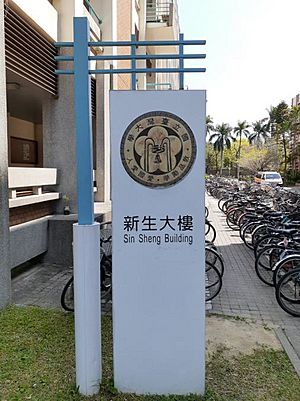
- Not Globally Standard: The main argument against it was that Hanyu Pinyin is the standard system used by Mainland China, the International Organization for Standardization, and the United Nations.
- Adds Confusion: Using Tongyong Pinyin created a third way to spell words, making things more complicated. For example, the "Qing dynasty" (Hanyu Pinyin) was also "Ch'ing dynasty" (Wade–Giles) and "Cing dynasty" (Tongyong Pinyin). This meant researchers had to know all three spellings for the same thing.
- Inconsistent Spelling: Critics also pointed out that Tongyong Pinyin could be inconsistent in how it spelled certain sounds.
How Tongyong Pinyin Compares to Hanyu Pinyin
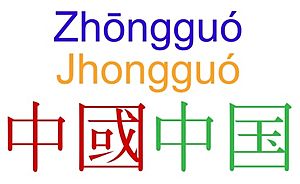
Here are some of the main differences between Tongyong Pinyin and Hanyu Pinyin:
- Palatal Sounds: Hanyu Pinyin uses j, q, x. Tongyong Pinyin uses j, c, s.
- Retroflex Sounds: Hanyu Pinyin uses zh, ch, sh. Tongyong Pinyin uses jh, ch, sh.
- "Buzzing" Vowels: Hanyu Pinyin uses i (like in shi, si). Tongyong Pinyin uses ih (like in shih, sih).
- ü Sound: Hanyu Pinyin uses ü (or u after some letters). Tongyong Pinyin uses yu.
- You and Wei Sounds: Hanyu Pinyin shortens these to iu and ui. Tongyong Pinyin often writes them out fully as iou and uei.
- Eng Sound: After f and w, Hanyu Pinyin uses eng. Tongyong Pinyin uses ong (like fong, wong).
- Wen Sound: Hanyu Pinyin uses wen. Tongyong Pinyin uses wun.
- Tone Marks: Tongyong Pinyin doesn't mark the first tone, but it can use a dot for the neutral tone.
| IPA | ɑ | ɔ | ɤ | aɪ | eɪ | ɑʊ | ɤʊ | an | ən | ɑŋ | ɤŋ | ɑɻ | ʊŋ | ji | iɛ | iɤʊ | iɛn | jin | jiŋ |
| Pinyin | a | o | e | ai | ei | ao | ou | an | en | ang | eng | er | ong | yi | ye | you | yan | yin | ying |
|---|---|---|---|---|---|---|---|---|---|---|---|---|---|---|---|---|---|---|---|
| Tongyong Pinyin | a | o | e | ai | ei | ao | ou | an | en | ang | eng | er | ong | yi | ye | you | yan | yin | ying |
| Wade-Giles | a | o | o/ê | ai | ei | ao | ou | an | ên | ang | êng | êrh | ung | i | yeh | yu | yen | yin | ying |
| zhuyin | ㄚ | ㄛ | ㄜ | ㄞ | ㄟ | ㄠ | ㄡ | ㄢ | ㄣ | ㄤ | ㄥ | ㄦ | ㄨㄥ | ㄧ | ㄧㄝ | ㄧㄡ | ㄧㄢ | ㄧㄣ | ㄧㄥ |
| example | 阿 | 哦 | 俄 | 艾 | 黑 | 凹 | 偶 | 安 | 恩 | 昂 | 冷 | 二 | 中 | 一 | 也 | 又 | 言 | 音 | 英 |
| IPA | wu | uɔ | ueɪ | uan | uən | uʊn | uɤŋ | uʊŋ | y | yɛ | yɛn | yn | yʊŋ |
| Pinyin | wu | wo | wei | wan | wen | weng | yu | yue | yuan | yun | yong | ||
|---|---|---|---|---|---|---|---|---|---|---|---|---|---|
| Tongyong Pinyin | wu | wo | wei | wan | wun | wong | yu | yue | yuan | yun | yong | ||
| Wade-Giles | wu | wo | wei | wan | wên | wêng | yü | yüeh | yüan | yün | yung | ||
| zhuyin | ㄨ | ㄨㄛ | ㄨㄟ | ㄨㄢ | ㄨㄣ | ㄨㄥ | ㄩ | ㄩㄝ | ㄩㄢ | ㄩㄣ | ㄩㄥ | ||
| example | 五 | 我 | 位 | 完 | 文 | 文 | 翁 | 翁 | 玉 | 月 | 元 | 云 | 用 |
| IPA | p | pʰ | m | fəŋ | fʊŋ | tiou | tuei | tʰ | ny | ly | kəɻ | kʰ | xə | tɕiɛn | tɕyʊŋ | tɕʰɪn | ɕyɛn |
| Pinyin | b | p | m | feng | diu | dui | t | nü | lü | ger | k | he | jian | jiong | qin | xuan | |
|---|---|---|---|---|---|---|---|---|---|---|---|---|---|---|---|---|---|
| Tongyong Pinyin | b | p | m | fong | diou | duei | t | nyu | lyu | ger | k | he | jian | jyong | cin | syuan | |
| Wade-Giles | p | p' | m | fêng | tiu | tui | t' | nü | lü | kêrh | k' | ho | chien | chiung | ch'in | hsüan | |
| zhuyin | ㄅ | ㄆ | ㄇ | ㄈㄥ | ㄉㄧㄡ | ㄉㄨㄟ | ㄊ | ㄋㄩ | ㄌㄩ | ㄍㄜㄦ | ㄎ | ㄏㄜ | ㄐㄧㄢ | ㄐㄩㄥ | ㄑㄧㄣ | ㄒㄩㄢ | |
| example | 玻 | 婆 | 末 | 封 | 封 | 丟 | 兌 | 特 | 女 | 旅 | 歌儿 | 可 | 何 | 件 | 窘 | 秦 | 宣 |
| IPA | tʂə | tʂɚ | tʂʰə | tʂʰɚ | ʂə | ʂɚ | ʐə | ʐɚ | tsə | tsuɔ | tsɨ | tsʰə | tsʰɨ | sə | sɨ |
| Pinyin | zhe | zhi | che | chi | she | shi | re | ri | ze | zuo | zi | ce | ci | se | si |
|---|---|---|---|---|---|---|---|---|---|---|---|---|---|---|---|
| Tongyong Pinyin | jhe | jhih | che | chih | she | shih | re | rih | ze | zuo | zih | ce | cih | se | sih |
| Wade-Giles | chê | chih | ch'ê | ch'ih | shê | shih | jê | jih | tsê | tso | tzŭ | ts'ê | tz'ŭ | sê | szŭ |
| zhuyin | ㄓㄜ | ㄓ | ㄔㄜ | ㄔ | ㄕㄜ | ㄕ | ㄖㄜ | ㄖ | ㄗㄜ | ㄗㄨㄛ | ㄗ | ㄘㄜ | ㄘ | ㄙㄜ | ㄙ |
| example | 哲 | 之 | 扯 | 赤 | 社 | 是 | 惹 | 日 | 仄 | 左 | 字 | 策 | 次 | 色 | 斯 |
| IPA | ma˥˥ | ma˧˥ | ma˨˩˦ | ma˥˩ |
| Pinyin | mā | má | mă | mà |
|---|---|---|---|---|
| Tongyong Pinyin | ma | maˊ | maˇ | maˋ |
| Wade-Giles | ma1 | ma2 | ma3 | ma4 |
| zhuyin | ㄇㄚ | ㄇㄚˊ | ㄇㄚˇ | ㄇㄚˋ |
| example (traditional/simplfied) | 媽/妈 | 麻/麻 | 馬/马 | 罵/骂 |
Images for kids
See also
 In Spanish: Tongyong pinyin para niños
In Spanish: Tongyong pinyin para niños
- Hanyu Pinyin
- Daighi tongiong pingim


